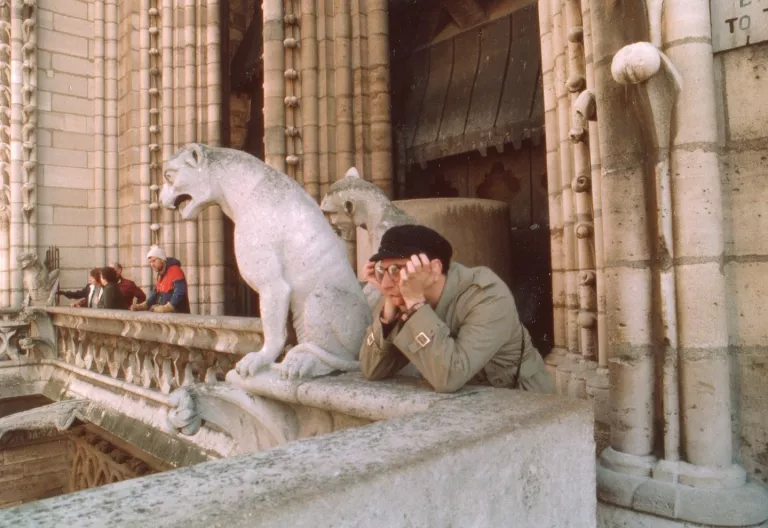- | Expert Commentary Expert Commentary
- |
Notre-Dame and the Myth of Timelessness
An Economist's Insight Offers a Ray of Hope in the Wake of Tragedy
Being Jewish, I have no natural affinity for Notre-Dame de Paris. Yet a few personal memories have bound my thoughts to the great cathedral for many decades. This week’s disaster breaks my heart, but even in this horror, I find a sense of uplift.
Let me describe my tenuous connections to Notre-Dame. Getting there requires some meandering through economics, but all for a purpose.
In 1981, while at Columbia University, I worked as a research assistant for Don Patinkin—one of the great monetary economists of the 20th century and, briefly, president of the Hebrew University of Jerusalem. Patinkin was a kindly gentleman but meticulous and demanding enough to drive colleagues insane. That reputation didn’t bother me; working for him was a great pleasure.
Patinkin’s Money, Interest and Prices was for a time considered by some to be the late century’s second-most important work on monetary theory. When I worked with him, he was seeking the historical tributaries leading to the century’s most important work—John Maynard Keynes’s The General Theory of Employment, Interest and Money. My job was helping Patinkin produce a book: Anticipations of the General Theory? And Other Essays on Keynes.
By reputation, economists are notoriously disinterested in the historical trails that led to present-day thinking. Many act as if the present state of economic reasoning was present at the Big Bang and will stand immutable until the sun flickers out. Given his outsized reputation as a theorist and empiricist, I asked Patinkin what led him to the little-appreciated doctrinal history. He said he liked the field because practically no one else did. If you’re the only one who cares, he said, it’s easy to be the leading authority on the topic.
My first assignment was to determine whether the first edition, first printing of Keynes’s book employed the Oxford comma. Was it The General Theory of Employment, Interest, and Money or The General Theory of Employment, Interest and Money? Pre-Internet, this required crawling through the gloomy stacks of libraries around Manhattan. It took a significant effort to find a first edition from 1936, and I proudly brought Patinkin the book. He shook his head and said this was a first edition, but not the first printing. Back I went. After some days, I found the rare text somewhere in Manhattan and brought it to him. He beamed like a child.
Why, I asked, did he care so much about the comma if, as apparently was the case, Keynes didn’t. He jutted his finger into the air, saying, “Because in Paris, there is the great Cathedral of Notre-Dame. And hundreds of feet up in the air, there are gargoyles, some of which are virtually never seen by anyone. Yet, hundreds of years ago, the sculptors who made them put great care into making them as perfect as they could, knowing even then that no one would ever be able to appreciate them.”
Patinkin’s offhand comment left a deep impression, altering my behavior a bit, making me a better economist and a better person.
Two years later, my then-future wife and I took our first great trip. We traveled together to Paris, and then I would fly from there to Nigeria—the first time I had ever left the United States. The most memorable portion of our trip was a visit to Notre-Dame. My small, history-obsessed hometown fawns over “historical” houses a mere 150 years old. At Notre-Dame, Alanna and I walked through the most impressive building we had ever seen—begun over 800 years earlier, mostly by illiterate workers using muscle-driven tools.
Patinkin’s words about precision and pride of authorship were on my mind with every minute piece of stonework I saw. Alanna and I climbed to the top to see the menagerie of gargoyles, chimeras, and other mythological beasts. The accompanying photo is my 1983 imitation of Notre-Dame’s best-known carving—“Le Stryge.”

The Notre-Dame of last week, like the economic doctrine that Don Patinkin studied, was not an immutable structure, unchanged since its completion around 1260. Over the centuries, the cathedral was ravaged by vandals, religious fanatics, revolutionaries, armies, and the general rot of ages. It has been reborn time and time again, as it shall be once more. With effort and luck, a century from now, pilgrims and tourists will look upon elements of the 21st-century restoration and assume, erroneously, that they date from the 12th or 13th centuries.
The internet today is filled with laments. Notre-Dame, they pine, will never be the same, and repairs will not likely be completed in our lifetimes. But that is a part of the beauty and the life of a cathedral. The original architects knew they would never see their creations finished. Like the sculptors Don Patinkin described to me long ago, the architects built for the Ages, not for themselves.
Vive la Cathédrale.